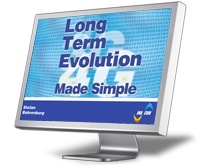 LTE Made Simple
LTE Made Simple
WBT Description

- This Web Based Training addresses the needs of everybody who needs to understand the technology and concepts of LTE as the future 4G standard of 3GPP.
- After the general introduction to 4G standards is given, the Web Based Training starts with an introduction of the requirements of LTE.
- The following part presents important characteristics of the key layer 1 technologies: OFDM and MIMO.
- The Web Based Training continues with a description of the LTE L1. Among others we evaluate in detail the application of essential technologies like OFDMA for the downlink and SC-FDMA for the uplink in LTE as well as the LTE frame structure.
- This part concludes with the discussion of the physical layer procedures.
- The next chapter evaluates in detail the higher layer protocols of E-UTRAN.
- This chapter is presenting the initial context setup procedure of LTE and is describing the data flow of a TCP/IP packet trough the protocol layers.
 Some of your questions that will be answered
Some of your questions that will be answered
- What is LTE and why it is introduced in the first place?
- What are the requirements for LTE and how do they differentiate from those of UMTS?
- What are the key characteristics of LTE’s (E-UTRAN’s) layer 1 and layer 2/3?
- How does the LTE and SAE (System Architecture Evolution) evolved mobile radio network look like?
- How do the basic physical layer technologies of LTE like OFDM and MIMO work?
- How the physical frame structure is facilitating the use of a flexible bandwidth allocation?
- How the physical layer procedures work in LTE?
- How the throughput of the UE categories can be calculated?
- What are the tasks of the higher layer protocol entities and functions of the enhanced node B: MAC, RLC, PDCP, and RRC?
- How in detail the TCP packets travel through the protocol layers?
 WBT Duration
WBT Duration
- app. 3 hours
 Detailed ToC
Detailed ToC
Part 1: Principles and Motivation of LTE
- Overview and Outlook of the technical Evolution
- Performance and Mobility Management related Issues
- Architecture related Issues
- Procedure and Radio related Issues
- Quiz 1: Mobile Radio Comparison
- Requirements on LTE
- AIPN - What does it mean?
- LTE and System Architecture Evolution (SAE)
- The Control Plane Protocol Stack
- The User Plane Protocol Stack
- X2 Interface Control Plane Protocol Stack
- X2 Interface User Plane Protocol Stack
- Channel Types
- Quiz 2: E-UTRAN Protocol Stack and Channel Overview
Part 2: Key Technologies of the LTE Physical Layer
- Introduction of OFDM Technology
- OFDM Principle and Example
- OFDM versus OFDMA
- OFDM versus OFDMA continued
- LTE Modulation schemes
- OFDM Issues and Solutions
- ... and the solution in OFDM: Cyclic Prefix
- Quiz 3: OFDM and Modulation
- The Basic Problems: Signal Fading Physics between TX and RX
- Possible Solutions: Smart Antenna Technologies
- MIMO Principle Operation
- Quiz 4: MIMO Principles
Part 3: The Physical Layer of E-UTRAN
- Logical Channels in E-UTRAN
- Transport Channels in E-UTRAN
- Physical Channels in E-UTRAN
- Uplink Direction - UE to eNB
- Downlink Direction - eNB to UE
- Quiz 5: LTE Physical Channel Details
- LTE Frame Structure (FDD)
- Resource Block and Resource Element Definition
- Overview of Important Identifiers in LTE
- Quiz 6: Frames and Identifiers
- Overview of Physical Layer Procedures
- Random Access Principle
- LTE Random Access Procedure
- UE Classes
- Quiz 7: Physical Layer Procedures and UE Classes
Part 4: The Higher Layers of E-UTRAN
- Features of the MAC Layer
- Features of the RLC Layer
- Features of the PDCP Layer
- Features of the RRC Layer
- RRC State Characteristics
- NAS Protocol States and Transitions
- Quiz 8: Higher Layer Protocols
- LTE and SAE Bearer Architecture and Relationships
- The QoS-Profile of the LTE / SAE-Bearer
- QoS Classes Identifier
- Security in LTE
- Quiz 9: QoS and Security
- The Initial Context Setup Procedure
- The Initial Context Setup Procedure (continued)
- The Initial Context Setup Procedure (continued)
- How a TCP/IP MTU reaches the UE / the Internet
- Quiz 10: Initial Attachment
Demo Version
Order
Product Details:
- 48 Slides
- 10 Quizzes
- Valid to: 23 Dec 2026
- Price: 169.- €
v1.000
ℹ️ Try out the updated search below!
Search:
Demo Version
Are You Curious?
If you interested in our Web Based Trainings, please contact us. We would be pleased to inform you.Our Web Based Trainings
We are proud to introduce the first INACON Web Based Trainings:
Our Advantages
Technology in 3 Hours
Expert Trainers
Audio + Video ...
Advanced Didactics
CBT vs. WBT
